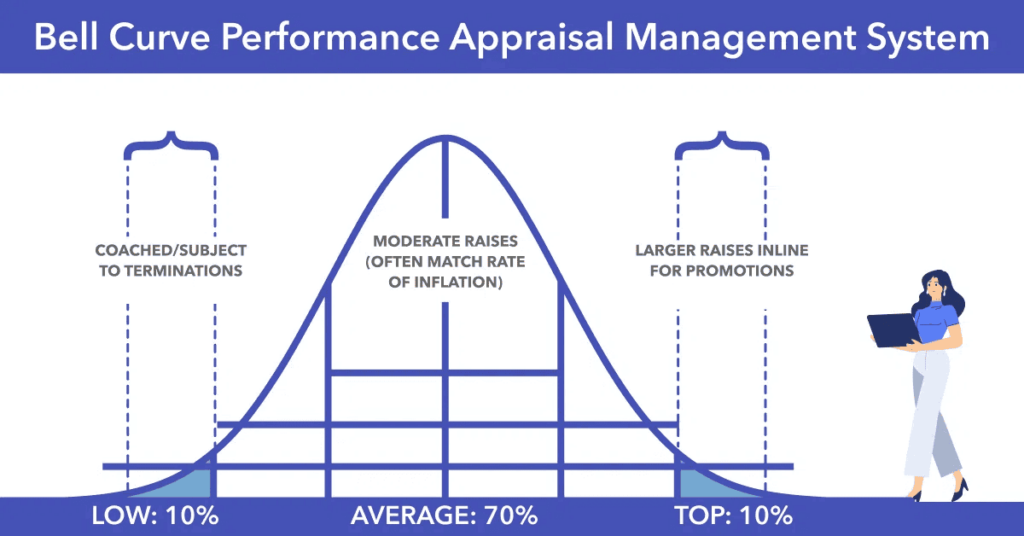
Are you stuck in a halt as an employer of a company? One reason could be that you need to correctly evaluate your employees’ performance. Performance evaluation is an essential part of any organisation’s success. And one of the most widely used methods to assess employee performance is the bell curve. But what exactly is the bell curve, and what are its pros and cons?
In this article, we’ll discuss what a bell curve is and what its benefits and drawbacks are.
Related articles:
Gamification: an innovative strategy to elevate engagement and performance
How to Write a Performance Improvement Plan (PIP) [Sample Template]
What is the Bell Curve?
The bell curve, also called a normal distribution, is a way to show how an employee is performing as compared to other employees. It is usually shown by data points like test scores or performance levels spread out in a group. It looks like a bell: wide in the middle and narrow at both ends. When you draw a bell curve, most people (like workers or students) sit around the average, while only a few are way at the top or bottom.

In other words, it means that if you measure something—say performance or test scores—most people score close to the average. Not many scores super high or super low. For instance, in job performance, most workers are rated as average, with just a small number being extremes, like brilliant or worst. In short, it is used to classify employees based on their performance level.
The bell curve goes back to early statistics and probability ideas. Carl Friedrich Gauss, a mathematician, is often credited with it because he used it for natural events. Over time, it became popular in management and human resources for evaluating worker performance systematically, much like how professional event photographers use systematic methods to capture the best moments at events.
Where is the Bell Curve Used?
The bell curve isn’t just for job evaluations. It’s used in lots of areas like education, psychology, economics, and finance. In schools, it can help make sense of test scores. And in finance, it helps look at stock market returns.
Even in retail, companies might apply similar concepts to track customer engagement with promotions, such as coupons & discounts, to better understand how different types of offers influence consumer behaviour. Basically, anywhere data needs to be understood by how often things happen is where you’ll find the bell curve.
The Bell Curve in Performance Evaluation
Now let’s focus on performance management. In evaluations using the bell curve, employees get sorted into groups: low performers, average performers, and top performers. This setup aims to give a clear way to rate big groups so that not everyone gets the same score.

Companies that use bell curves often rank their staff based on specific performance measures. Usually, around 70% are placed in the average group. About 15% become top performers, while another 15% get marked as lower achievers. This method keeps things interesting and helps avoid “rating inflation,” where managers might hand out too many high scores. Here are its key features.
- Ranking: Employees get ranked compared to each other.
- Percentage Allocation: Only certain percentages can be assigned to each group (top tier, middle tier, and low tier).
- Performance Metrics: Clear standards are set for evaluating workers—this keeps things fair.
Linking ratings directly to this system means employees are compared against one another instead of just looking at goals set ahead of time. This approach can help you identify the high achievers and areas needing improvement, ultimately working to skyrocket your brand’s potential.
Advantages of Bell Curve in Performance Appraisal
The bell curve is one of the most used tools in appraising the performance of employees of a company.
Encourages differentiation among employees
The first advantage of this method is that it makes differentiation among employees. The method ensures that there’s clarity between low, average, and high performers. Through this, the manager won’t be giving high ratings to his favourites.
Creates competition
The bell curve creates healthy competition among employees. Since the curve differentiates employees based on their performance, it creates a competitive atmosphere in the workplace. Employees will try and push their limits to get an edge over their fellow employees.
Identifies high performers
The bell curve method makes it easy to recognize top performers of the company. They could be equally rewarded for their performance with bonuses, promotions, or additional responsibilities.
Reduces Bias
A good bell curve system stays fair without personal favoritism. It ensures that people are appraised based on structured approaches rather than personal bias. So, no more worry about the manager favouring his favorite employees.
Standardized method
It is a solid ranking structure, and it brings consistency—great for larger companies. However, integrating project management tools can provide a more nuanced view of performance, especially in collaborative projects.
Disadvantages of Bell Curve in Performance Appraisal
It is not particularly correct to say that the bell curve methods have only advantages. Every coin has two faces, and just like any other method, the bell curve method has the following disadvantages:
Create unhealthy competition
While healthy competition is good for progress, the bell curve sometimes creates a cutthroat competition. It makes employees prioritize individual achievement over teamwork. This may become detrimental to the organization’s growth.
Demoralizes average or low ranking employees
As far as most workers are concerned, they will always fall within the “average category,” which may demotivate them. Those placed in the low end can feel disheartened even though they have contributed significantly to the team.
Inflexibility for small teams or departments
It is often difficult to apply the bell curve in small teams because there may not be evident differences in performance among team members. This method is particularly suited to big groups or companies with a large number of employees.
Not always reflective of actual employee performance
According to some critics, this method does not represent the actual performance of every employee working within an organization. If the majority of a team performs well, it feels unfair to force some employees into the lower performance bracket simply to satisfy the distribution.
Risks of ignoring collaboration and teamwork
Since a bell curve appraisal makes aspiring employees compete against each other, instead of encouraging teamwork, it focuses more on individual performance, highlighting the need for effective project management software.
Other Ways to Evaluate Performance
There are many other methods that don’t use the bell curve and might be comparatively fair.
- 360-Degree Feedback: The 360-degree feedback method collects feedback from peers, seniors, and juniors too—it gives a more comprehensive picture of performance.
- Management by Objectives (MBO): In this method, an employee is evaluated based on how well they meet their daily, weekly, and monthly goals. This method doesn’t compare employees with other employees.
- Continuous Performance Management: Focuses on regular check-ins instead of just yearly reviews—helps adjust things more swiftly.
- Competency-Based Evaluations: Here people are judged based on skills needed for their job rather than ranking against each other.
Is the Bell Curve Still Useful?
The bell curve was mostly used back in the ’90s and early 2000s. But now many companies have moved on from this method. Tech giants like Microsoft and General Electric now prefer newer methods that are more personalized. Today’s businesses value collaboration and teamwork much more than individual performance. The rigid structure of a bell curve doesn’t always align with what’s needed now. So, “Continuous Feedback Systems” have started trending.
More companies have realized that this method ignores teamwork and lowers spirits among workers. They’re looking for systems that focus on learning and growth instead.
Conclusion
The bell curve has been popular for years in performance appraisals—but no system is perfect. While it sorts out employees nicely, it can hinder team spirit too. As ways to assess work improve over time, companies seek more adaptable methods. The bell curve might stick around, but remember—there’s no one right way when judging employee performance. You are the best person to judge which method is best for your organization.




